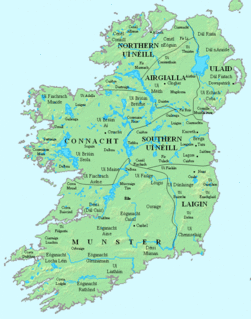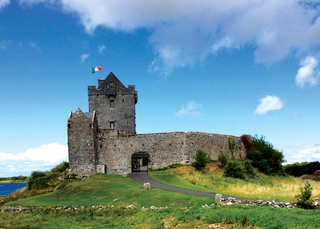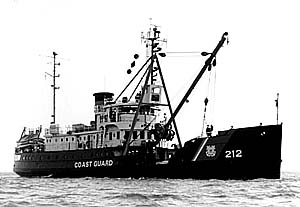
Connacht, formerly spelled Connaught, is one of the provinces of Ireland, in the west of Ireland. Up to the 9th century it consisted of several independent major kingdoms.

Firs (Abies) are a genus of 48–56 species of evergreen coniferous trees in the family Pinaceae. They are found through much of North and Central America, Europe, Asia, and North Africa, occurring in mountains over most of the range. Firs are most closely related to the genus Cedrus (cedar). Douglas firs are not true firs, being of the genus Pseudotsuga.
In signal processing, a finite impulse response (FIR) filter is a filter whose impulse response is of finite duration, because it settles to zero in finite time. This is in contrast to infinite impulse response (IIR) filters, which may have internal feedback and may continue to respond indefinitely.

Ó Seachnasaigh, O'Shaughnessy, collectively Uí Sheachnasaigh, clan name Cinél nAedha na hEchtghe, is a family surname of Irish origin. The name is found primarily in County Galway and County Limerick. Their name derives from Seachnasach mac Donnchadh, a 10th-century member of the Uí Fiachrach Aidhne, which the Ó Seachnasaigh were the senior clan of. The town of Gort, Ireland, was the main residence of the family since at least the time of their ancestor, King Guaire Aidne mac Colmáin.

Uí Fhiachrach Aidhne was a kingdom located in what is now the south of County Galway.

Aidhne, also known as Uí Fhiachrach Aidhni, Mag nAidni, later Maigh Aidhne, was the territory of the Uí Fhiachrach Aidhni, a túath located in the south of what is now County Galway in the south of Connacht, Ireland.. Aidhne is coextensive with the present diocese of Kilmacduagh. The territory of Aidhne is bounded on the west by Loch Lurgan and the barony of Burren in County Clare in the province of Munster. County Clare also bounds Aidhne on its south and south-east side. Aidhne is bounded on the east by the low mountains of Sliabh Echtghe / Slieve Aughty, which separate Uí Fhiachrach Aidhni from the territory of Uí Maine in eastern County Galway. On the north-east Aidhne is bounded by the plains of Uí Mhaine and on the north by Mag Mucruime. On the north-west Aidhne is bounded by the parish of Mearaí / Maree which is in the territory of Uí Briúin Seola.

Dunguaire Castle is a 16th-century tower house on the southeastern shore of Galway Bay in County Galway, Ireland, near Kinvara. The name derives from the Dun of King Guaire, the legendary king of Connacht. The castle's 75-foot (23 m) tower and its defensive wall have been restored, and the grounds are open to tourists during the summer.
Cóiced Ol nEchmacht is an ancient name for the province of Connacht, Ireland.

O'Cleary is the surname of a learned Gaelic Irish family. It is the oldest recorded surname in Europe — dating back to 916 CE — and is cognate with cleric and clerk. The O'Clearys are a sept of the Uí Fiachrach dynasty, who ruled the Kingdom of Connacht for nearly two millennia. As Connachta, the O'Cleary's ruled the kingdom of Uí Fiachrach Aidhne for nearly 800 years. They are the descendants of Fiachrae, son of the High King Eochaid Mugmedon, and elder brother of legendary High King Niall of the Nine Hostages. According to legend, they ultimately trace their ancestry back to the mythical Fir Bolg, as well as to Milesius, and consequently to Japheth, son of Noah.
Events from the year 1180 in Ireland.

The United States Coast Guard Cutter Fir was the last lighthouse tender built specifically for the United States Lighthouse Service to resupply lighthouses and lightships, and to service buoys. Fir was built by the Moore Drydock Company in Oakland, California in 1939. On 22 March 1939, the U.S. Lighthouse Tender Fir was launched. She was steam driven with twin screws, 175 feet (53 m) in length, had a beam of 32 feet (9.8 m), drew 11 feet 3 inches (3.43 m) of water, and displaced 885 tons. Fir was fitted with a reinforced bow and stern, and an ice-belt at her water-line for icebreaking. She was built with classic lines and her spaces were lavishly appointed with mahogany, teak, and brass. The crew did intricate ropework throughout the ship. The cost to build Fir was approximately US$390,000. Fir's homeport was Seattle, Washington for all but one of her fifty one years of service when she was temporarily assigned to Long Beach, California when USCGC Walnut was decommissioned on 1 July 1982.

Fiddaun Castle is a tower house in Tubber, County Galway, close to the border of County Clare in Ireland. It is a National Monument of Ireland.

Clarina is a village in County Limerick in the province of Munster, Ireland. It lies between Mungret and Kildimo on the N69 National Route about 6 miles west of Limerick city close to the River Maigue. The Maigue is a tributary of the River Shannon and enters the Shannon estuary between Limerick city and the mouth of the Deel river, Askeaton, county Limerick.
Cían d'Fhearaibh Bolg, last King of the Senchineoil of Magh Senchineoil, now in County Galway, Ireland.
Aengus mac Umor was a mythical Irish king.
The Ciarraige Óic Bethra were a population-group found in early medieval Ireland.
The Ciarraige Aí were a population-group found in medieval Ireland.
The Uí Fiachrach were a royal dynasty who originated in, and whose descendants later ruled, the coicead or fifth of Connacht at different times from the mid-first millennium onwards. They claimed descent from Fiachrae, an older half-brother of Niall Noigiallach or Niall of the Nine Hostages. Fiachrae and his two full brothers, Brion and Ailill, were the collective ancestors of the Connachta dynasty that eventually became the new name of the province. Their mother was Mongfind.
Diarmait Ó Cobhthaigh was an Irish poet.








